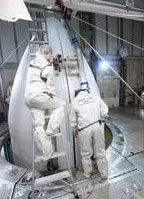
An unmanned U.S. rocket blasted off on Saturday from Cape Canaveral Air Force Station in Florida to deliver twin robotic probes to the moon in the hope of learning what is inside.
An unmanned U.S. rocket blasted off on Saturday from Cape Canaveral Air Force Station in Florida to deliver twin robotic probes to the moon in the hope of learning what is inside.
The 124-foot (37.8-meter) booster soared off its seaside launch pad at 9:08 a.m. EDT, arcing over the
 Less than two hours later, both probes were flying freely from the rocket's upper-stage motor and were communicating with NASA's Deep Space Network.
Less than two hours later, both probes were flying freely from the rocket's upper-stage motor and were communicating with NASA's Deep Space Network.
"I couldn't be more pleased," Jim Adams, deputy director of NASA's planetary division, told reporters after the launch.
Liftoff of the Delta 2 rocket occurred two days later than planned due to high winds at the launch site and because of time required to review data on the rocket after its tanks were drained of fuel following an earlier launch scrub on Thursday.
The twin satellites on board are headed to a point in space 932,0570 miles away where gravitational pull from the Sun and Earth balances out.
From there, the NASA Gravity Recovery and Interior Laboratory, or GRAIL, satellites will make a long, slow approach to the moon, arriving on December 31 and Jan 1.
The twin GRAIL probes are designed to precisely map the moon's gravity so scientists can learn what lies beneath the lunar crust and whether the moon's core is solid, liquid or some combination of the two.
Combined with high-resolution imagery, ongoing analysis of rock and soil samples returned by the 1969-1972 Apollo missions and computer models, the gravity maps are expected to fill in the biggest missing piece in the puzzle of how Earth's natural satellite formed and evolved.
MAPPING MOON GRAVITY
The small boxy probes are designed to fly single file over the lunar poles, mapping the dips and swells in lunar gravity.
Linked by radio waves, the spacecraft will be able to detect changes in the tug of lunar gravity as small as one micron -- about the width of a red blood cell.
Pockets of terrain with more mass will cause first one and then the second satellite to speed up slightly as they fly over, changing the distance between the two probes in minute, but measurable amounts. Less dense regions will cause the probes to slow slightly.
The measurements are so precise that scientists have to factor out a myriad of other forces, including the pressure of sunlight and the gravitational influences of all other planets in the solar system, even the dwarf planet Pluto, currently about 2.9 billion miles (4.7 billion km) away.
Scientists believe the moon's building blocks were large chunks of debris jettisoned from Earth after a collision with an object as big as Mars.
The moon's ancient face reveals a history of impacts over the eons and other events, such as flowing rivers of molten lava. The GRAIL researchers' job is to determine how all these processes impacted the moon internally.
"Large impacts deposit a great deal of energy into a planet. They heat the interior. They potentially could cause the convection pattern to change. They can contribute to the way a planet de-gasses," said Massachusetts Institute of Technology planetary scientist Maria Zuber, lead researcher and manager of the $496-million GRAIL mission.
Besides unraveling the moon's history, GRAIL scientists expect to extrapolate their findings to other rocky bodies, both in our solar system and eventually to those beyond.
United Launch Alliance, a joint venture of Lockheed Martin and Boeing, manufacture and provide launch services for the Delta 2 rocket. Lockheed Martin also is the prime contractor on the GRAIL satellites.

 Previous page
Previous page Back to top
Back to top







